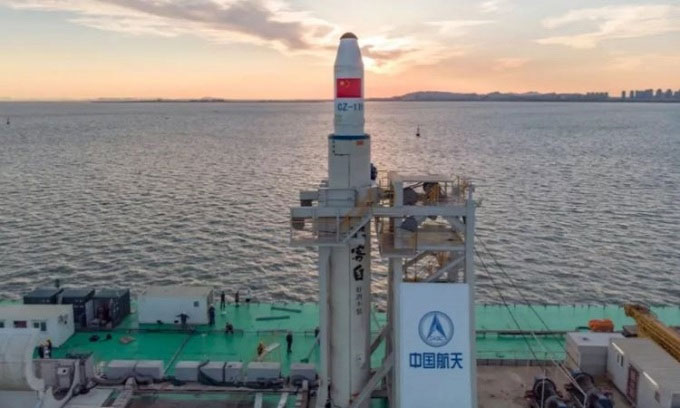The vessel is specially designed to launch missiles into space from the sea, enhancing China’s satellite launch capabilities and booster recovery.
The new type of missile launch ship measures 162.5 meters in length and 40 meters in width and is being constructed for use alongside the Eastern Spaceport in Haiyang, Shandong Province. It is expected that the new ship will be operational by 2022. The vehicle will integrate launch support equipment and can accommodate the Long March 11 rocket, the larger commercial “Smart Dragon” rocket, and future liquid-fueled rockets. The ship will also be used to recover the first stage of the rocket, similar to how SpaceX’s autonomous droneships provide landing platforms for the Falcon 9 and Falcon Heavy rockets.

Long March 11 rocket on the De Bo 3 offshore launch platform in the Yellow Sea before the launch on September 15, 2020. (Image: CASC)
China has conducted two launches of the solid-fuel Long March 11 rocket from the Yellow Sea, using a modified barge, with the most recent launch occurring in September 2020. These missions have made China the third country to conduct offshore launches, following the United States and Russia. Earlier this year, China’s main space contractor announced plans to launch 2-3 Long March 11 rockets at sea this year. The new ship will help increase the frequency of offshore launches in China and alleviate pressure on the four main launch centers.
In 2021, China achieved a record of 41 launches, surpassing the United States (39 launches) for the highest number of orbital launches in a year. With the increasing number of commercial companies and current plans for satellite constellation development, offshore launches will provide more flight paths to orbit.
The flexible location of the launch area means authorities can more easily choose flight paths and ensure that used rocket stages and other debris fall into the sea rather than on land. Debris from land-based launches in China often falls to the ground and sometimes lands near populated areas. Mobile offshore launch platforms also allow for launches closer to the equator. The greater rotational speed of the Earth near the equator means that the vehicles will require less fuel.
The Eastern Port project is being developed in collaboration with the China Academy of Launch Vehicle Technology (CALT), the main rocket manufacturer under the China Aerospace Science and Technology Corporation (CASC), along with the city of Haiyang. The facility in Haiyang also has the capability to assemble and test rockets, producing up to 20 solid rockets each year. In the future, this facility will manufacture more complex liquid-fueled rockets.


















































